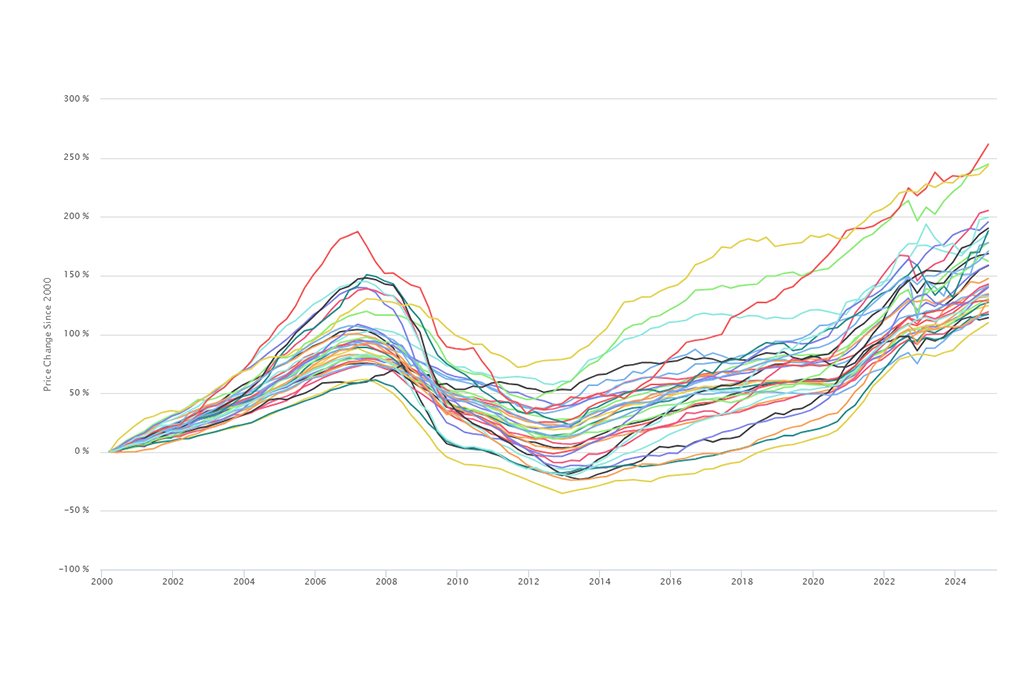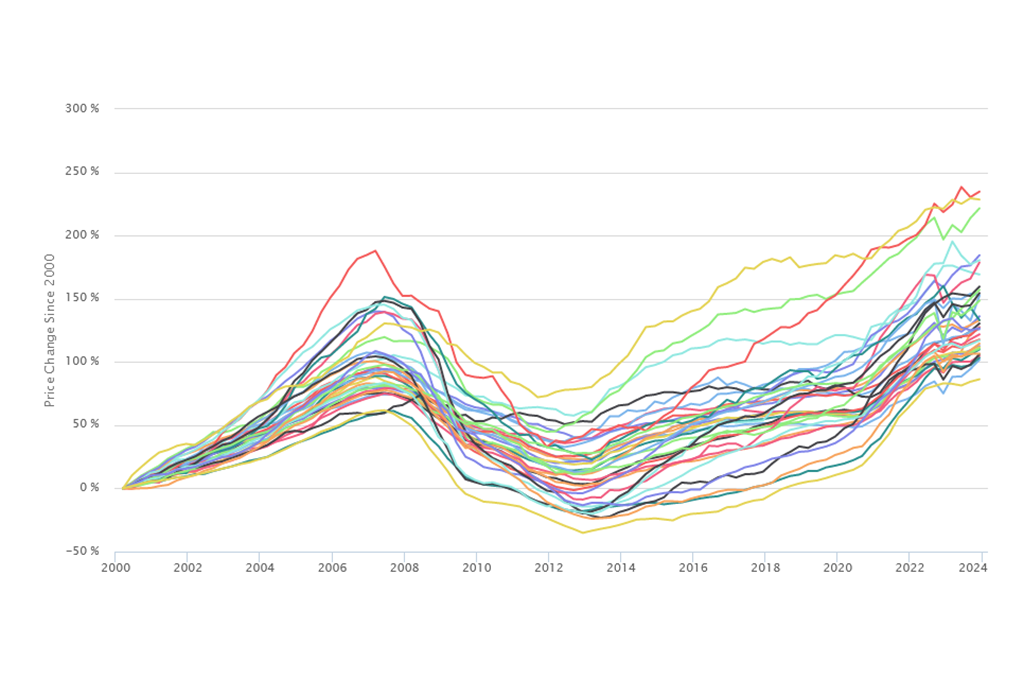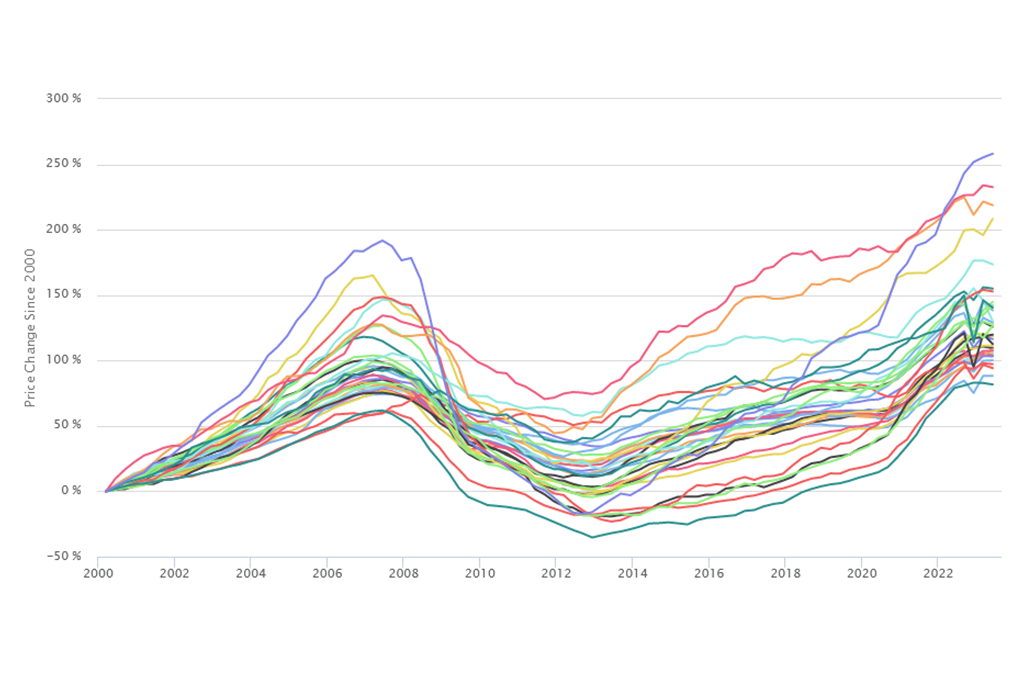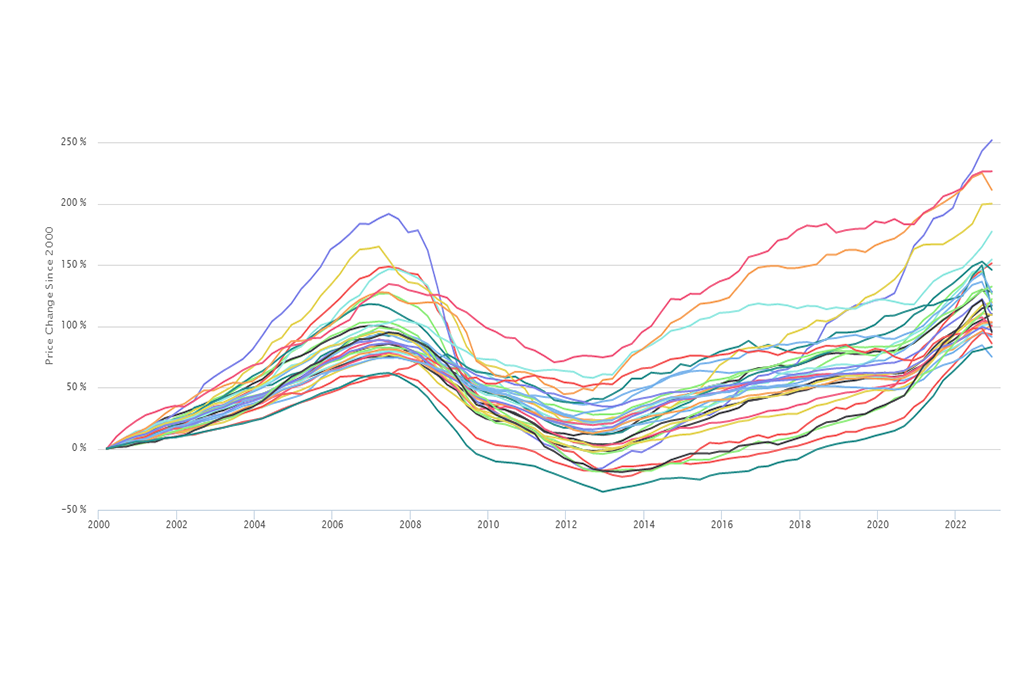This update of the Institute for Housing Studies (IHS) Cook County House Price Index highlights changing prices for single-family homes through the second quarter of 2016 in 16 City of Chicago submarkets and 17 submarkets primarily in suburban Cook County. A detailed discussion of the Index is below. To view a full page interactive graph with a map and data for all submarkets go here. Underlying price index data can be found here.
Key Findings
Year-over-year price changes
- Areas with the largest increases in prices between the second quarters of 2015 and 2016 include Chicago submarkets Bridgeport/Brighton Park, Humboldt Park/Garfield Park, and Austin/Belmont Cragin, where price levels increased by 21.5 percent, 15.5 percent, and 11.6 percent respectively. These three areas are all adjacent to strong markets of Logan Square/Avondale and West Town/Near West Side.
- North suburban Winnetka/Northbrook was the only area that saw a decline in house prices in the second quarter of 2016 compared to the same time the previous year. Prices in this submarket declined by less than one percent. Other areas that experienced slower growth include suburban LaGrange/Burbank and Lake View/Lincoln Park in the City of Chicago. Both experienced annual price increases of 2.5 percent.
- The median Cook County submarket experienced a 6.2 percent increases in prices compared to the previous year. In the City of Chicago the median submarket experienced a 6.5 percent increase, and in suburban Cook County, prices in the median submarket increased by 5.3 percent.
Peak to current
- As of the second quarter of 2016, four City of Chicago submarkets (Lake View/Lincoln Park, Logan Square/Avondale, West Town/Near West Side, and Lincoln Square/North Center) had exceeded previous peak price levels seen during the height of the housing bubble by at least three percent. All other submarkets remain below their bubble era peaks.
- Despite recent price improvements, Englewood/Greater Grand Crossing and South Chicago/West Pullman in the City of Chicago continue to be the two submarkets furthest below previous peak levels. Both of these areas experienced very large price bubbles during the housing boom and severe declines when the market collapsed. Prices in Englewood/Greater Grand Crossing are nearly 56.9 percent lower than they were at the market peak while prices in South Chicago/West Pullman are over 50 percent lower.
- Compared to the peak of the market, prices in the median Cook County submarket are still off by 22.1 percent. Prices in the median City of Chicago submarket are 26.9 percent less than they were at peak levels, although there is substantial variation between city submarkets. In suburban Cook, prices in the median submarket are 21.7 percent off peak levels.
Recovery from bottom
- As of the second quarter of 2016, all submarkets in Cook County have experienced at least 13 percent price increases compared to their lowest post-recession price levels. Areas with the largest increases from price bottoms include Humboldt Park/Garfield Park and Logan Square/Avondale. These areas both have single-family house prices that are more than 77.7 percent and 61 percent higher than their respective price bottoms.
- The weakest recoveries have been primarily seen in suburban Cook County. The is largely due to the suburbs being less volatile housing markets that have experienced less dramatic price peaks and valleys than seen in many City of Chicago submarkets. However, the weak suburban recovery means that prices in 11 of 17 suburban submarkets remain at least 20 percent off peak levels. The suburban area with the weakest recovery is south suburban Chicago Heights/Park Forest where prices increased by just 13 percent from its price bottom.
- House prices in the median Cook County submarket have recovered by 27.5 percent since the bottom of the market. In the City of Chicago, the median submarket has seen prices rebound by 36.7 percent compared to 25 percent in suburban Cook.
- The map below shows the variation in the recovery from the bottom of the market to current price levels for submarkets in Cook County. Areas with the strongest recoveries are submarkets on the west side of the City of Chicago and in west suburban Cook County. These areas are seeing increased demand for housing coming from either owner occupants competing for properties in hot urban neighborhoods or investors seeking opportunities in distressed markets. Conversely, areas with a slower recovery, even those generally considered stable markets in northwest and southwest suburban Cook County, have seen a weaker recovery and may be struggling with attracting new demand for housing.
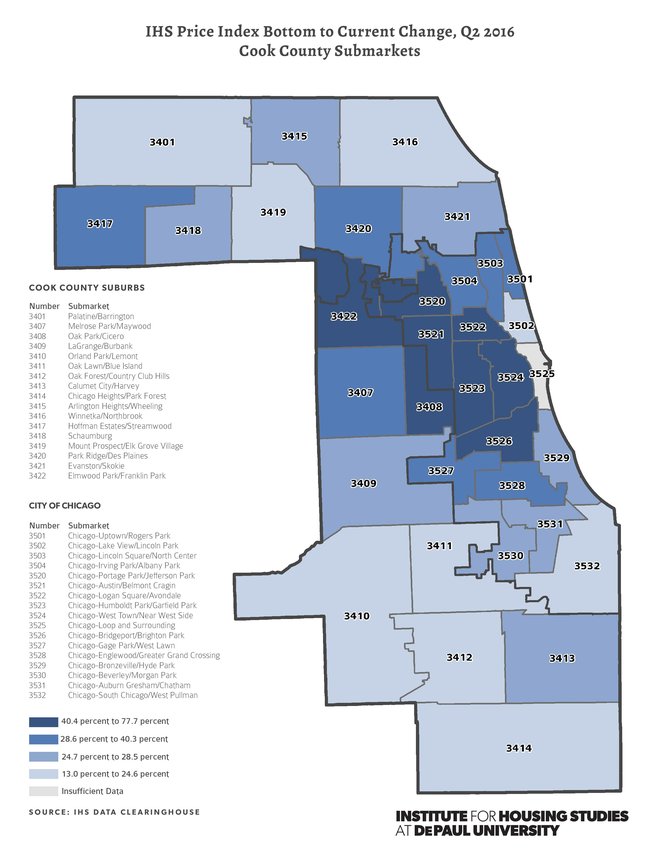 Bottom to Current Change, Q2 2016 Cook County Submarkets
Bottom to Current Change, Q2 2016 Cook County Submarkets
Price changes since 2000
- As of the second quarter of 2016, two Cook County submarkets continue to experience price levels below their year 2000 price levels. Prices in suburban Calumet City/Harvey were 18.1 percent less than levels in the year 2000, while price levels in the area in and around suburban Chicago Heights/Park Forest were over 6.8 percent below prices in 2000. In the City, the South Chicago/West Pullman submarket reached 2000 price for the first time since the third quarter of 2011.
- Price levels in three Chicago submarkets were more than double what they were in 2000 as of the second quarter of 2016. This includes the West Town/Near West Side (144 increase from 2000 levels); Logan Square/Avondale (138.9 percent above 2000 levels) and Lincoln Square/North Center (115.8 percent from 2000 levels).
- House prices in the median Cook County submarket have increased by 49.8 percent since 2000. In the City of Chicago, prices in the median submarket have increased by 57.5 percent compared to 47.3 percent in suburban Cook.
To view a full page interactive graph with a map and data for all submarkets go here. Underlying price index data can be found here.
Background on Price Indices
House price trends are one of the most important indicators of a neighborhood’s economic health, and understanding how these trends vary within the City of Chicago and suburban Cook County is critical to those working to develop policies and investment strategies sensitive and responsive to local market dynamics and household financial conditions. To help housing stakeholders, policymakers, and the public understand this issue better, the Institute for Housing Studies (IHS) has developed a submarket-level Cook County house price index to track quarterly price trends for single family homes in 16 submarkets in the City of Chicago and 17 submarkets in suburban Cook County. In recent years, substantial focus has been paid to the importance of house price trends as a national or regional indicator of economic conditions, but growing attention is being paid to the implications uneven price declines and recoveries across neighborhoods have for communities and their residents. Neighborhoods with rapidly rising prices may be those facing current or future housing affordability concerns, while areas with slow price recovery may need strategic investment to rebuild demand for housing. Additionally, the uneven nature of house price declines and recovery across neighborhoods is a stark illustration of the growing divide between thriving and struggling communities and households. Home equity is one of the key vehicles for families to build wealth, and the variation in price trends can be an indicator of household financial conditions across communities measured by the level of home equity gained and lost by households and neighborhoods over time.
More About IHS' Cook County Submarket Indices
The submarkets in IHS’s price index are based on Public Use Microdata Areas (PUMAs) from the 2010 US Census. There are 16 submarkets in the City of Chicago and 17 that are primarily in suburban Cook County. In the City of Chicago, the submarket surrounding the Loop has been excluded because of insufficient levels of single family home sales. Click here for a reference guide to the community areas and suburban municipalities found in each submarket. Additional detail about the model can be found at the end of this analysis.
The discussion below highlights four key metrics for analyzing house price trends and describes their patterns and their implications for communities:
Year over Year – This metric illustrates the short-term price trend and compares the current price level as of the second quarter 2016 with the price level in the second quarter 2015. Areas with large changes in price levels tend to be a mix of markets with recent increased demand. These include highly foreclosure distressed areas where prices are starting to recover, and rapidly appreciating “hot” markets. Historically strong markets tend to have low but steady appreciation year over year. Interpreted in conjunction with other price trend indicators, year over year price changes can be helpful in identifying rebounding markets with stabilizing prices.
Recovery from Bottom – This metric measures the change in price level from a submarket’s lowest point after the 2008 collapse of the housing market to the second quarter of 2016. It tracks the speed of recovery of single family house prices from the point that prices in that submarket reached their recent lowest price level. This indicator is an important measure for recent buyers who purchased properties near the bottom of the market and who are trying to understand the return on that investment. It is also a valuable indicator for understanding where investment has been flowing in recent years. This “recovery” metric is a product of recent demand for housing outstripping the supply of homes for sale in these areas. This demand could be driven by owner occupants competing for a limited supply of for-sale housing in “hot” markets or investors competing for the dwindling supply of low-cost properties in more distressed markets. This recovery metric should be interpreted in conjunction with other price trend data points, however.
Peak to Current –This metric measures the difference between a submarket’s peak price level at the height of the housing boom and the current price level as of the second quarter of 2016, and it captures the recovery of a neighborhood’s house prices towards previous price peak levels. Often, neighborhoods that saw a the substantial build up in prices during the housing bubble experienced equally dramatic declines. While those price peaks were often inflated and unsustainable, recovery towards those peaks is an important benchmark for homeowners who bought their homes or obtained a mortgage from 2005 to 2007 when prices were at their highest.
Many homeowners are reluctant to sell their homes for less than what they paid, and, in cases where a mortgage is involved, areas that are well below previous peak values are likely to have larger numbers of underwater or near-underwater homeowners. As values get closer to previous peak levels, more homeowners are likely willing and able to sell, more households will exit underwater status, and equity lost during the housing crisis is rebuilt. In areas where values remain well below peak levels, many homeowners likely remain underwater. Owning more on a mortgage than what a property is worth limits an owner’s ability to sell their property and puts a greater strain on a household’s financial conditions.
Price trends since 2000 – This metric tracks the change in price levels from the first quarter of 2000 to the second quarter 2016 and measures long-term price trends. The variation in neighborhood price trends since 2000 is a key indicator of the impact the housing crisis and uneven housing recovery has had not just on local housing markets, but also on long-term homeowners. Home equity is a key asset for both lower- and higher-income households, and increasing equity over time is one of the ways that both lower- and higher-income households build wealth. Areas where there has been limited long-term price appreciation are areas where long time owners benefit less from increasing home equity compared with long-term owners in areas with significant appreciation.
The Model
Using its data clearinghouse, IHS has developed a hedonic price index model to provide a stable mechanism to track submarket-level price trends. Unlike a repeat sales model which requires a matched pair of sales on a single property and can be less stable at smaller geographies, a hedonic model combines data on a property’s sales price with data on the physical characteristics of that property and its location relative to key amenities or disamenities. The statistical model controls for factors that contribute to price and allows for the development of an index tracking price changes of the typical, non-distressed home over time and is ideal for tracking price trends at the submarket level.
Click here for more information on IHS’s hedonic price index model.

